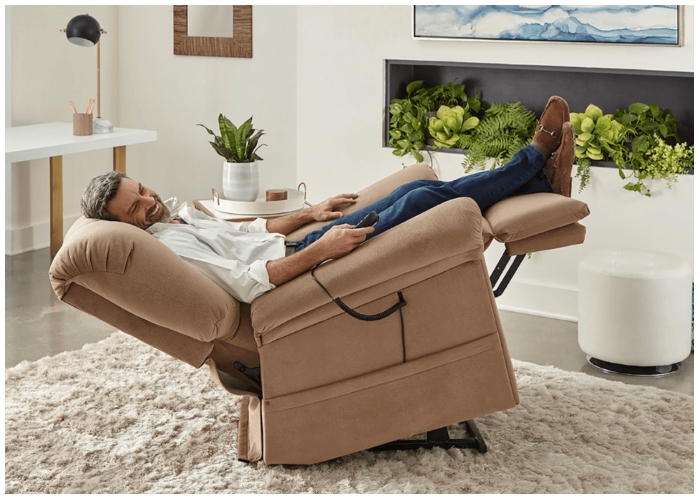For years, home design was driven by aesthetics first and comfort second. Magazine-ready living rooms, sculptural seating, and curated vignettes ruled the conversation—but 2025 is shaping up to be the year we finally stopped pretending we don’t want to actually enjoy being in our homes. Whether you live in a small city apartment or a spacious suburban house, people are realizing that home should be a sanctuary, not a showroom. Comfort-first design doesn’t mean sacrificing style—it means choosing materials, layouts, and pieces that feel good to live with. And as work-from-home lifestyles, wellness priorities, and mental health awareness continue to shape our daily routines, comfort has become less of a luxury and more of a requirement.
Prioritizing How a Space Feels Over How It Photographs
Social media once dictated how homes were styled, with every corner curated to look good in a square frame. But in 2025, more people are rejecting the pressure to design for likes and instead focusing on how their spaces actually make them feel. That shift is leading to homes that are warmer, softer, and more lived-in. It’s not about messy versus clean—it’s about how the space supports your daily life. People are embracing imperfect materials, cozy textiles, and organic shapes because they feel welcoming and lived-in, not staged or stiff. When the couch you sink into at the end of the day is more important than how it looks on your feed, you’ve officially joined the comfort-first movement.
The Rise of Sensory Design
Comfort isn’t just about cushions and throws—it’s about how a space engages all your senses. In 2025, designers are paying closer attention to lighting, texture, sound, and even scent. Natural lighting is being prioritized more than ever, with layered lighting setups replacing harsh overhead fixtures. Materials like boucle, linen, and soft woods are being used to add tactile warmth. Sound-absorbing rugs and soft-close cabinetry reduce environmental stress. Even paint colors are being chosen based on their emotional effect, with serene tones like sage, oatmeal, and warm grays replacing sterile whites and moody blacks. The result is a home that’s not just stylish, but restorative.
Furniture That Supports the Body and the Lifestyle
For a long time, design trends favored chairs and sofas that looked sculptural—but weren’t exactly comfortable to sit on. In 2025, ergonomics and softness are finally catching up to aesthetics. Plush sectionals with deep seating, adjustable chairs that promote posture, and modular pieces that can be reconfigured for lounging or entertaining are becoming the new norm.

People are no longer choosing between pretty and practical. Coffee tables are getting rounded edges. Beds are being layered with mixed textiles for coziness. Even outdoor furniture is mimicking the plushness of indoor living. The future of furniture isn’t just about making a statement—it’s about making you want to stay a while.
Letting Go of Rigid Minimalism
Minimalism has long dominated interior trends, but many are now realizing that sparse spaces don’t necessarily equal calm ones. Comfort-first design doesn’t mean clutter—it just makes space for personality, softness, and flexibility. The rigid rules of “less is more” are being replaced with “what works for you.” Books are allowed back on shelves. Blankets are thrown over couches without perfectly folded corners. Art is hung at eye level, not based on gallery grids. People are choosing warmth over coolness, lived-in over curated, and functional over pristine. This evolution in minimalism reflects a broader desire for homes that are emotionally nourishing, not just visually clean.
Home as a Wellness Tool
Comfort-first design is also a reflection of how we’re redefining wellness. It’s not just about scented candles or a yoga mat in the corner. It’s about how your home can actively support your mental and physical health. That means choosing fabrics that feel good on your skin, seating that supports your body, and layouts that reduce stress. It means making space for rest—not just sleep—and curating rooms that feel safe and personal. Plants that are easy to care for, air purifiers that blend into the decor, blackout curtains for better sleep, and quiet zones for breaks from screens are all part of this new wellness-first approach to comfort. Your home is no longer a backdrop to your life—it’s part of your healing.
Style That Doesn’t Expire
Comfort-first design doesn’t mean throwing away your aesthetic values—it just means choosing timelessness over trendiness. Pieces that feel good rarely go out of style. Soft shapes, calming palettes, and natural materials aren’t just more comforting—they’re more sustainable. By focusing on how things feel instead of how fast they can get attention, people are building homes that evolve with them instead of chasing the next wave of fast decor. In 2025, the future of design looks less like a catalog and more like your favorite corner of the house—the one where you actually want to spend time.